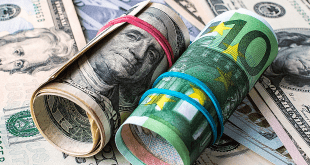U.S. Stocks Show Mixed Results at Close; Dow Jones Industrial Average Gains 0.12%
The U.S. stock market closed with mixed results on Friday, with the Dow Jones Industrial Average reaching a new all-time high, while the S&P 500 edged higher and the NASDAQ Composite index ended lower.
The Dow Jones Industrial Average rose by 0.12%, reaching a new record high, while the S&P 500 index added 0.11%. However, the NASDAQ Composite index fell by 0.12%.
Among the top performers on the Dow Jones Industrial Average were 3M Company, Walt Disney Company, and Verizon Communications Inc, while Apple Inc (NASDAQ: AAPL), Walmart Inc, and Amgen Inc were among the worst performers.
On the S&P 500, Estee Lauder Companies Inc, The AES Corporation, and Boston Properties Inc were among the top gainers, while Carnival Corporation, Moderna Inc, and ON Semiconductor Corporation (NASDAQ: ON) were among the top losers.
In NASDAQ trading, Avalo Therapeutics Inc, Biodexa Pharmaceuticals PLC DRC, and CERo Therapeutics Holdings Inc were among the top gainers, while Primech Holdings Ltd, Tonix Pharmaceuticals Holding Corp, and Gamida Cell Ltd were among the top losers.
Overall, falling stocks outnumbered advancing ones on both the New York Stock Exchange and the Nasdaq Stock Exchange.
In commodities trading, gold futures rose, while crude oil prices also saw gains.
The euro was relatively unchanged against the dollar, while the dollar index futures edged higher.
German Stocks Show Mixed Results at Close; DAX Rises by 0.15%
After Friday’s trading session, Germany’s stocks exhibited a mixed performance, with gains in the Food & Beverages, Media, and Consumer & Cyclical sectors driving shares higher, while losses in the Construction, Transportation & Logistics, and Software sectors pulled shares lower.
At the close in Frankfurt, the DAX climbed by 0.15%, reaching a new all-time high. Conversely, the MDAX index dipped by 0.07%, while the TecDAX index saw a modest gain of 0.02%.
Among the session’s top performers on the DAX were Siemens Energy AG, which saw a rise of 3.03%, Merck KGaA gaining 2.12%, and Rheinmetall AG increasing by 1.84%.
Conversely, Deutsche Post AG NA O.N. experienced a decline of 1.42%, Dr Ing hc F Porsche AG Preferred dropped by 1.37%, and Brenntag AG fell by 1.06%.
On the MDAX, Aixtron SE led the gainers, rising by 2.47%, while SMA Solar Technology AG saw the most significant decline, dropping by 5.56%.
In the TecDAX, Cancom SE O.N. surged by 4.22%, while Energiekontor AG experienced the most notable decline, dropping by 9.85%.
Rheinmetall AG saw its shares reach all-time highs, rising by 1.84%, while Redcare Pharmacy NV reached 52-week highs, gaining 1.78%.
Overall, falling stocks outnumbered advancing ones on the Frankfurt Stock Exchange.
The DAX volatility index, which gauges the implied volatility of DAX options, increased by 3.74% to 12.77.
Nikkei Records Largest Point Gain of the Fiscal Year in Japan
On Friday, Japan’s Nikkei share average closed higher, primarily driven by chip-related heavyweights, and marked a record fiscal-year gain in terms of points, largely due to substantial foreign buying.
Throughout this month, the index consistently reached record highs, surpassing levels last seen on Feb. 22, 1989, during Japan’s bubble economy era. This impressive rally was fueled by foreign investment, supported by a weaker yen and expectations of the Bank of Japan maintaining loose monetary policies.
For the fiscal year ending on Friday, the Nikkei surged by 12,328 points, representing its most significant gain in absolute terms. It posted a remarkable 44% increase over the year, marking its strongest performance since the fiscal year ended March 2021.
On the final trading day, the Nikkei closed up 0.5% at 40,369.44, rebounding from losses in the previous session.
Fumio Matsumoto, Chief Strategist at Okasan Securities, noted that investors are cautious about potential currency market interventions, but generally perceive the weakened yen as a positive factor for domestic stocks.
Tokyo Electron and Advantest, both chip-related companies, saw increases of 0.79% and 1.85%, respectively.
The property sector surged by 1.96%, registering a 16% increase this month, the highest among sectors. This surge was supported by a government survey indicating that land prices in Japan rose at the fastest pace in 33 years in 2023.
Matsumoto attributed the optimism surrounding the property sector’s stock prices to the belief that the Bank of Japan will maintain a gradual approach to interest rate hikes.
Oil
Crude oil prices surged during the final week of market transactions, heading towards achieving gains for the third consecutive month. These increases were driven by several key factors that supported market optimism and fueled concerns over potential supply shortages.
- Geopolitical Tensions in the Red Sea: The ongoing geopolitical tensions between American forces and Houthi groups in the Red Sea region contributed significantly to the rise in crude oil prices. Reports of the US Central Command intercepting unmanned aerial systems launched by the Houthis, aimed at coalition and US warships, heightened concerns about potential disruptions in global oil supply. These tensions injected uncertainty into the market, pushing prices upward.
- Optimism Surrounding US Economic Growth: Positive economic data from the Bureau of Economic Analysis in the United States bolstered market sentiment and contributed to the surge in oil prices. The final data for the economic growth rate in the US during the last quarter of the previous year exceeded market expectations, with gross domestic product (GDP) growth reaching 3.4%. This surpassed earlier projections of 3.2%, indicating a stronger-than-anticipated economic recovery. The optimistic outlook for US economic growth fueled expectations of increased demand for crude oil in the future, further supporting oil prices.
As a result of these developments, spot contracts for Brent crude recorded a significant rise of 1.49% to reach $86.92 per barrel, while spot contracts for West Texas Intermediate crude jumped by approximately 1.73% to $83.06 per barrel. Both benchmarks are poised to achieve gains for the third consecutive month, underscoring the sustained upward momentum in crude oil prices.
Economic Indicators
In an unexpected turn, US consumer sentiment surged in March to its highest level in nearly three years, largely fueled by growing confidence in the gradual softening of inflationary pressures.
The University of Michigan’s renowned Consumer Sentiment Index reached a final reading of 79.4 for the month, marking its highest level since July 2021, up from February’s 76.9. This figure surpassed consensus estimates of 76.5 from a Reuters poll of economists, aligning with the preliminary March estimate released two weeks earlier.
Both current economic conditions and future outlooks saw improvements compared to mid-March and February readings.
Notably, expectations regarding inflation over a one-year horizon dipped to 2.9% from February’s 3.0%, matching January’s figure, which represented the lowest level since December 2020. Over a five-year horizon, consumers anticipated a moderation in inflation to 2.8%, down from 2.9% in the previous month.
This unexpected uptick in consumer sentiment suggests a growing sense of optimism among Americans, driven in part by the belief that inflationary pressures may be gradually subsiding.
The latest report from the Commerce Department reveals that the U.S. economy expanded at a faster pace than previously estimated in the fourth quarter of last year. This growth was primarily driven by robust consumer spending and increased business investment in nonresidential structures such as factories and healthcare facilities.
Additionally, the report highlighted a solid increase in profits during the last quarter, particularly among nonfinancial corporations. This upward trend in profits, coupled with a rise in worker productivity, may incentivize companies to retain their workforce, thereby contributing to the continuation of economic expansion.
Despite concerns and speculations about a potential recession, the U.S. economy has demonstrated resilience, even amidst significant interest rate hikes by the Federal Reserve totaling 525 basis points since March 2022 aimed at curbing inflation. While momentum has moderated, the U.S. economy continues to outperform its global counterparts.
Furthermore, the report indicates a moderation in underlying inflation pressures during the last quarter. However, these developments have not altered expectations regarding the U.S. central bank’s stance on interest rates. It is widely anticipated that the Federal Reserve will commence rate cuts by June, in line with previous forecasts.
 Noor Trends News, Technical Analysis, Educational Tools and Recommendations
Noor Trends News, Technical Analysis, Educational Tools and Recommendations




